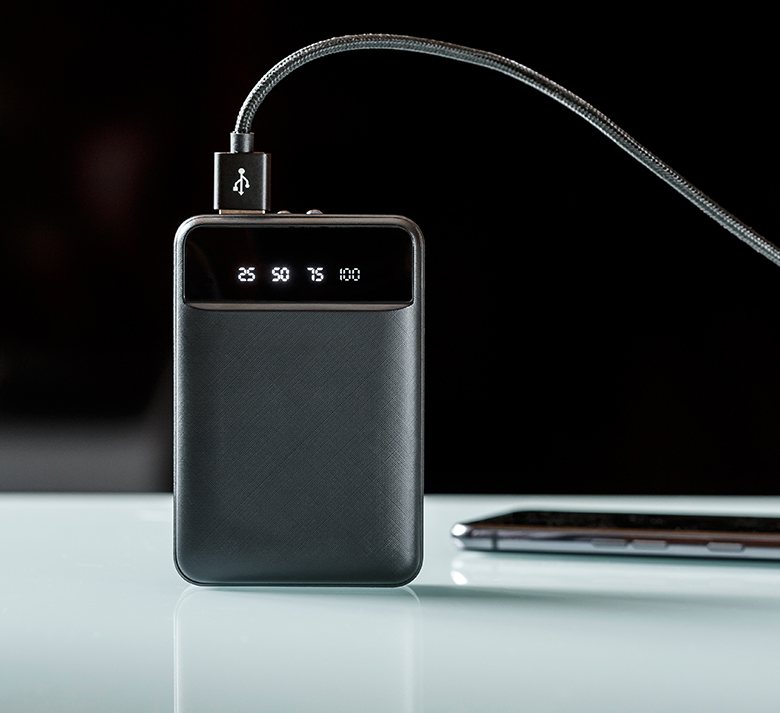With the increase in the use of mobile gadgets, as well as recent blackouts, the need for external batteries has also increased. One of the most popular types has become the Power Bank, which allows you to quickly and conveniently charge gadgets at any time and in any place.
How to choose a reliable and high-quality Power Bank? One of the determining parameters when choosing a portable device is its capacity. In this article, you will learn exactly why this factor is so important, how to calculate the real capacity of a Powerbank, and how to understand how many charges you can get from this device.

Let’s first understand what is the capacity of a Power Bank?
It determines how many times the Power Bank can charge your mobile device before it needs to be charged again.
Capacity is measured in milliampere-hours (mAh) and shows how much power the device can store. Therefore, the larger the capacity of the power bank, the more charges you can get for your mobile device.
Before calculating the real capacity, you need to familiarize yourself with such concepts as:
• loss ratio;
• convertible capacity;
• efficiency factor (efficiency);
• phone battery capacity.
The converted capacity of the power bank is the real energy released by a fully charged external battery, taking into account all losses, namely: during energy transfer and storage, charging and discharging, temperature effects, etc.
Let’s first understand what is the capacity of a Power Bank?
It determines how many times the Power Bank can charge your mobile device before it needs to be charged again.
Capacity is measured in milliAmp-hours (mAh) and shows how much energy the device can store. Therefore, the larger the capacity of the power bank, the more charges you can get for your mobile device.
Before calculating the real capacity, you need to familiarize yourself with such concepts as:
• loss ratio;
• convertible capacity;
• efficiency factor (efficiency);
• phone battery capacity.
The converted capacity of the power bank is the real energy released by a fully charged external battery, taking into account all losses, namely: during energy transfer and storage, charging and discharging, temperature effects, etc.

The cable loss ratio is a measure that determines how much of the signal is lost when passing through the cable. Each cable has its own loss factor, which depends on its design, material, length, signal frequency and other factors. The higher the loss ratio, the less signal remains at the output of the cable, which can lead to a deterioration in the quality of the signal or even its loss.
The coefficient usually varies from 4% to 15%, on average – 8%. There is a different coefficient for different types of overbanks. It depends on the capacity of the power bank, the material of the electrodes, the type and quality of the materials used and the production technology of the power bank.
Efficiency coefficient (Efficiency) is a coefficient that takes into account the conversion of the chemical energy of the power bank into electrical energy, which is used to charge your gadget. It is usually in the range of 0.80 to 95.
The capacity of a phone’s battery is the amount of electrical energy that the battery can store, and is measured in milliamp-hours (mAh).
Battery capacity may vary depending on the phone manufacturer, model and specifications. For example, in most modern smartphones, the battery capacity can be from 2000 to 5000 mAh.
Now that you have a certain understanding of each element, we can move on to calculating the actual capacity of the Power Bank:

Now let’s use a real example to find out how many times the Ridea RP-D40L Phoenix40 40000mAh/3.7V external battery with a 20cm cable can charge an Apple iPhone 13 Pro Max mobile device.
We record the data:
1) Converted capacity – 23200 mAh (58% of 40000 mAh)
2) The loss ratio is an average of 8%
3) Efficiency – 0.85
4) iPhone 13 Pro Max battery capacity is 4352 mAh

Judging by the result, the Ridea RP-D40L 40000mAh power bank will be able to charge the Apple iPhone 13 Pro Max approximately 5 times.

Let’s summarize.
A Power Bank is a device that allows you to charge mobile gadgets anywhere and anytime. Its capacity may differ from that indicated on the case, because the real capacity depends on the efficiency and losses, which in turn depend on the mobile device and the charging cable. In order to correctly calculate the real and converted capacity of a Power Bank, it is important to research the specifications of both devices before purchasing.
To obtain the maximum real capacity, it is recommended to choose devices with the highest efficiency and lower losses.
You should also pay attention to the specifications of the mobile device and choose a Power Bank with a larger capacity than the phone, which will ensure a full charge of the gadget.
It is important to remember that a Power Bank is an additional power source that cannot completely replace a regular battery. Therefore, it is recommended to use it only in emergencies and to charge the device, not for constant charging. So choosing a Power Bank can be difficult, but understanding the actual and converted capacity will help you make the right choice and get the most out of your device.
